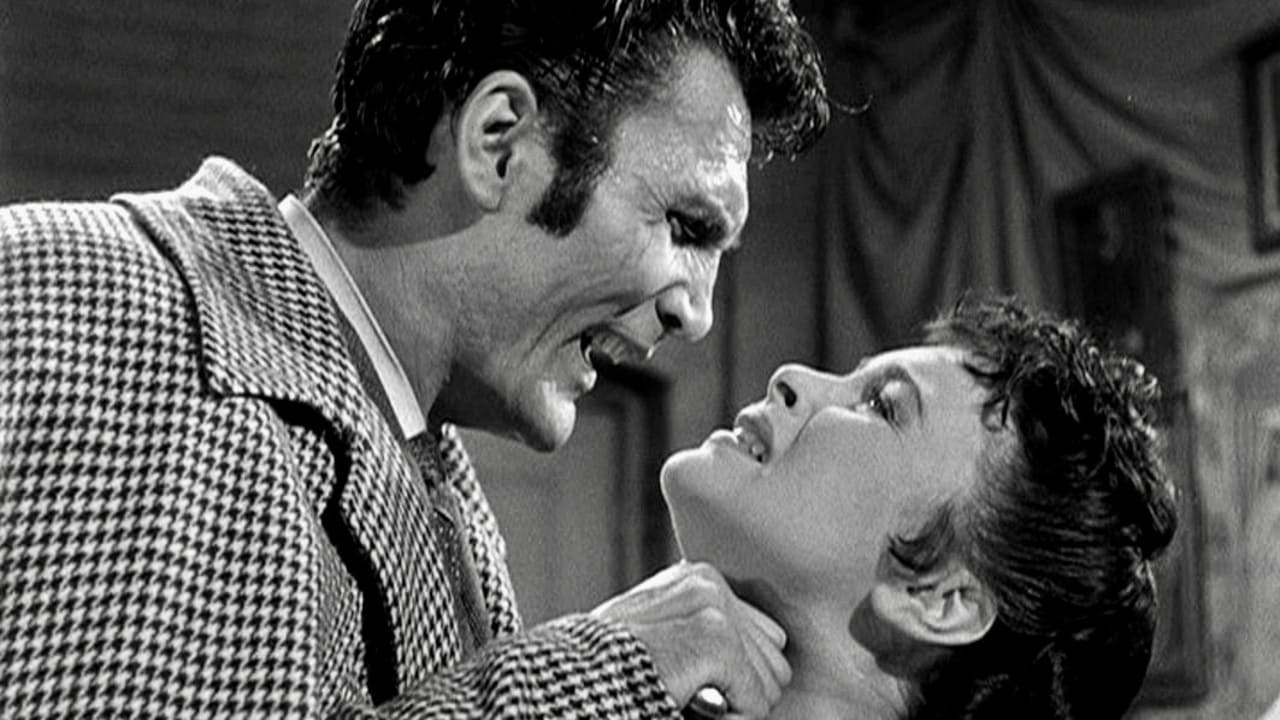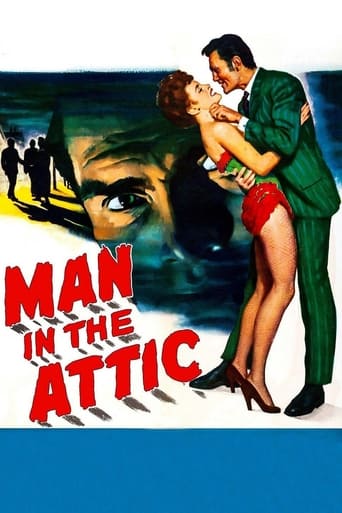

This film has been quite well-reviewed elsewhere here, so I will confine myself to making some pertinent comments left pretty much unaddressed elsewhere: For a film that depends so much on late-19th century English atmosphere, and somewhat achieves it visually, the accents of the six leading actors in it can be jarring, to say the least. Only Lester Matthews as a senior inspector really sounds British. Jack Palance sounds unambiguously American, as does Frances Bavier, while Rhys Williams as Bavier's husband sounds Welsh (which he was). Byron Palmer, who had only recently opened his mouth in TONIGHT WE SING to have Jan Peerce's voice come pouring out, was not a bad actor, but was a very poor choice for an English police inspector (especially next to George Sanders in the 1944 version) and also comes over as totally American. Constance Smith was Irish, but even she sounds more American than British. This wouldn't be important in a film with characters of diverse national backgrounds (think CASABLANCA), but a polyglot Jack the Ripper story is unconvincing.Many of the distance or action scenes in this film (the police climbing balconies, rooftops and the like) are actually taken right out of 1944's THE LODGER, and only portions of such scenes re-filmed to show the actors in this production, thereby contributing to its B-movie appearance.Constance Smith is quite good, and far more believable in her role than was Merle Oberon nine years earlier. Ms. Oberon came over as a bit too mature and certainly a bit too classy to be a Music Hall Queen, and she did not dance or high kick half as well as Ms. Smith.The Ripper is described as 'of average height', yet Jack Palance is anything but of average height and build and is of such huge presence that he would stand out in almost any crowd.Motivation is considerably changed between the 1944 and 1953 versions: In the earlier film, Cregar's character is psychologically forced to do the things he does by the death of his beloved brother, brought to ruin by a loose actress. In the 1953 version, he hates women of the streets (read prostitutes) because his mother was a truly nasty piece of work and ended up as one of them.Most amazingly, in the 1953 version, mention is made of his mother's name and a bright detective recalls that that was the name of Jack's first victim, and we then see the cops looking at a picture of her. Although this provides a tie-in to Slade, it is never again mentioned, nor is the fact that this would imply that Slade murdered his mother in the street to start off his killing spree (a possible shock to a 1953 movie-goer's system in that pre-Norman Bates era!). Also, we see a photo of a reasonably young woman, yet if Slade is, say, in his early 30s, she would have to have been at least 50.No mention is made of the fact that the two victims we do see and get to know a little are played by veteran actresses Isabel Jewell (memorable in everything she ever did) and Lillian Bond (a British-cum-American leading lady of the 1930s who was Melvyn Douglas's love interest in the original THE OLD DARK HOUSE). The latter character, who had starred at the Music Hall where the Smith character is now achieving much success, is not nearly as well defined as in the 1944 version.In the final chase through the streets, care has not been taken to disguise the fact that the driver of Slade's horse and carriage bears absolutely no resemblance to Jack Palance.Palance is truly excellent in this, yet the somewhat 'hammier' (not meant pejoratively) performance by Laird Cregar seems more memorable, if only for the earlier film's extraordinary 'heavy-breathing' sequence (sans music or any other sound) from Cregar when he is, as they say, cornered like a rat.As everyone agrees, the songs heard here are both out of place for this story, and out of fashion for its period, but so were the ones in the 1944 version. The whole thing would have made more sense and been more believable had Lily been an actress in, say, an Oscar Wilde play, rather than a Music Hall star.Despite the accent problem and a lack of true suspense throughout, it is certainly enjoyable to be reminded of just how well Jack Palance was doing at the time (think of the evil hired gun in SHANE, the actor pushed to murderous intent in Joan Crawford's SUDDEN FEAR, and only a bit later, the crushed actor in THE BIG KNIFE) and to see him here in one of his less well-remembered films from that period.
... View MoreMan in the Attic (1953)Economical, moody, funny and suspenseful both, and overall a smart, tight film. If you're like me you'll not be able to stop watching it even though you know it isn't quite a great movie, not at all.So. Why doesn't it work? Two main reasons, I think. First, the star, Jack Palance, known for being creepy and a little out of control in short bursts, isn't let loose. In fact, his Pennsylvania grittiness is made poorly into a late 19th Century British researcher who has restraint and brooding mystery. It's just a bad fit, and Palance, always most brilliant as a character actor, doesn't fill up the part at all, try as everyone might.Which makes me want to emphasize that the rest of the cast is very good or even terrific. The older couple is hilarious and believable, and quite facile with little jokes and jabs. The charming daughter is surprisingly charming despite her thin role (it's a bit caricatured). And the reset of the cast, coming and going, does a solid job.The second reason the movie wobbles is just the plot, the Jack the Ripper kind of tale that ends up as simple as it seems, even though you are thinking all the while, no way, that's too obvious. Well, I don't want to give any more away, but you'll see. If you have the choice, see the really terrific earlier version, "The Lodger," with George Sanders and Laird Cregar. That one needs no apologies. Nor, exactly, does the "first" of these (there is no first with such an iconic idea of a killer living in your house) by Hitichcock, also called "The Lodger," which adds the huge Hitchcockian twist that the wrong man is arrested as The Ripper and this man, as usual, has to prove his innocence on the run. See that one, though it's a silent film and many of the common prints out there are poor.As I started to say, though, I think if you start this you'll finish it. It's really fast, it has great almost archetypical foggy London night scenes, and it has lots of banter that you have to be paying attention to or you'll miss the wit. There are some dismissible choreographed upper crust dance hall scenes (that sounds like an oxymoron, but the dancing is pure chorus line junk and it's occurring in a upscale theater as if a serious London revue). And there is Palance, draining every scene he's in.
... View MoreA young Jack Palance (even when he's young he looks old) is the mysterious Mr. Slade who rents a room from Aunt Bea and her husband while conducting various experiments in the attic. His late night comings and goings raises suspicion that he in fact might very well be Jack the Ripper. If there is any doubt that he is the Ripper himself from the first scene forward than Man in the Attic will politely beat you over the head with various red flags. While not murdering local drunks and prostitutes (Ooops, Did I spoil it?) Slade becomes smitten with Lily the niece of the husband and wife he is renting the rooms from. Unfortunately for Jack, I mean Slade, Inpsector Warwick of Scotland Yard falls head over heels in love with Lily as well while investigating one of Slade's (Damn! Did it again!) the Ripper's murder of Lily's friend. It doesn't help Slade's hatred of women when he find out that Lily is a local vaudeville star that flaunts off her various wares to men on a weekly basis. Just imagine Britney Spears circa late nineteenth century. By the way, the musical performances by Lily, while not bad, just seem so out of place in this movie considering the contents of the plot. Man in the Attic has plenty of solid performances though most of the American actors didn't even attempt an English accent which is kind of bizarre. Constance Smith is quite fetching as Lily Bonner and nobody has more intimidating screen presence than Jack Palance who towers over his fellow actors. My one main concern is that this movie never once creates any suspense and it makes no attempt to throw you off path which is essential to films like this. The fact that I have to give a spoiler alert is downright laughable as it was clear who Slade really was from the moment he appeared on screen. Yes, Slade was Jack the Ripper. Believe it or not!
... View MoreCuriously tepid re-telling of the Jack the Ripper legend. Jack Palance certainly looks the part. With his rictus-like face, long lean body, and sinister smile, he's the most unusual of figures. However his Ripper comes across as more neurotic than menacing. As his scenes with Smith suggest, he's emotionally vulnerable, soft-spoken, even with a slight unmasculine lisp and a rampant mother-fixation. Now this is an interesting interpretation of the serial killer. Still and all, it works against Palance's appearance and the menace the role needs. In short, it makes for an interesting psychological profile, but not for the imposing personality that would stir an audience. Palance certainly can't be accused of overplaying the role.There's also too little of the glistening cobblestone streets and alleyways that create the needed background gloom. Likely the budget didn't allow for much of that atmospheric embroidery. Then too, director Hugo Fregonese does't appear to have a stylish feel for the material, which he films in a pretty straightforward unimaginative manner. What the movie does have is a gorgeous Constance Smith in a lively and compelling performance. Whatever happened to her. With her looks and talent, she should qualified for A-list parts, but her career looks a little mysterious, petering out in Italy in the late 50's.Anyway, it's a good chance to scope out the early Jack Palance in a performance that unfortunately falls short of his absolutely spine-chilling gunfighter in the classic Western Shane (1953).
... View More